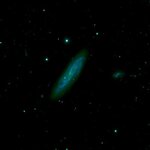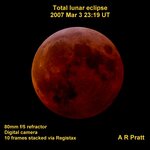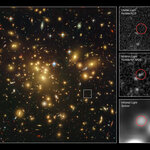Space

The Large Binocular Telescope on Mount Graham, Ariz., has taken celestial images using its twin side-by-side, 8.4-meter (27.6 foot) primary mirrors together, achieving first "binocular" light.
U.S., Italian and German partners in the telescope, known as the LBT, are releasing the images today. First binocular light is a milestone not only for the LBT, “now the world's most powerful telescope" but for astronomy itself, the partners say. The University of Arizona in Tucson is a quarter owner of telescope observing time.
The first binocular light images show three false-color renditions of the…

Astronomers using NASA's Hubble Space Telescope have compiled a large catalog of gravitational lenses in the distant universe. The catalog contains 67 new gravitationally lensed galaxy images found around massive elliptical and lenticular-shaped galaxies. This sample demonstrates the rich diversity of strong gravitational lenses. If this sample is representative, there would be nearly half a million similar gravitational lenses over the whole sky.
The lenses come from a recently completed, large set of observations as part of a huge project to survey a single 1.6-square-degree field of sky (…

A University of British Columbia astronomer with an international team has discovered the largest structures of dark matter ever seen. Measuring 270 million light-years across, these dark matter structures criss-cross the night sky, each spanning an area that is eight times larger than the full moon.
“The results are a major leap forward since the presence of a cosmic dark matter web that extends over such large distances has never been observed before,” says Ludovic Van Waerbeke, an assistant professor in the Dept. of Physics and Astronomy.
To glimpse the unseen structures, the team of…

Venus, it turns out, is a planet of extraordinarily changeable and extremely large-scale weather. Bright hazes appear in a matter of days, reaching from the south pole to the low southern latitudes and disappearing just as quickly. This kind of ‘global weather’, unlike anything on Earth, has given scientists a new mystery to solve.
The cloud-covered world of Venus is all but a featureless, unchangeable globe at visible wavelengths of light. Switch to the ultraviolet and it reveals a truly dynamic nature. Transient dark and bright markings stripe the planet, indicating regions where solar…

ESA’s Integral has made the first unambiguous discovery of high-energy X-rays coming from a rare massive star at our cosmic doorstep, Eta Carinae. It is one of the most violent places in the galaxy, producing vast winds of electrically-charged particles colliding at speeds of thousands of kilometres per second.
The only astronomical object that emits gamma-rays and is observable by the naked eye, Eta Carinae is monstrously large, so large that astronomers call it a hypergiant. It contains between 100–150 times the mass of the Sun and glows more brightly than four million Suns put together.…

People across the western hemisphere may be surprised to see a rust-colored Moon in the sky in a few days - an ominous omen to ancient people but a more predictable occurrence now. Early on 21 February (the evening of the 20 February for observers in North and South America) will be this year’s first and only total eclipse of the Moon.
Bonus: unlike the solar equivalent, the whole event is safe to watch and needs no special equipment.
In a total lunar eclipse, the Earth, Sun and Moon are almost exactly in line and the Moon is on the opposite side of the Earth from the Sun. The Moon is full,…

Scaled versions of Jupiter and Saturn orbiting a star 5000 light-years away, half as massive as the Sun, have been revealed from an effort involving a world-wide net of telescopes, including the UK's Liverpool Telescope on the Canary Islands.
This marks the first discovery of another system of planets that has striking similarities with our Solar System. Moreover, it suggests that such giant planets do not favour the single-life but are more likely to be found in family groups. The research is published in the 15th February issue of Science.
Whilst there are more than 250 planets now known,…

Detailed images from Hubble’s Near Infrared Camera and Multi-Object Spectrometer (NICMOS) reveal an infant galaxy, dubbed A1689-zD1, undergoing a firestorm of star birth as it comes out of the dark ages, a time shortly after the Big Bang, but before the first stars completed the reheating of the cold, dark Universe. Images from NASA’s Spitzer Space Telescope’s Infrared Array Camera provided strong additional evidence that it was a young star-forming galaxy in the dark ages.
“We certainly were surprised to find such a bright young galaxy 13 billion years in the past”, said astronomer Garth…

The elliptical galaxy NGC 1132 (Hubble picture and video below) belongs to a category of galaxies called giant ellipticals. NGC 1132, together with the small dwarf galaxies surrounding it, are dubbed a “fossil group” as they are most likely the remains of a group of galaxies that merged together in the recent past.
In visible light NGC 1132 appears as a single, isolated, giant elliptical galaxy, but this is only the tip of the iceberg.
Scientists have found that NGC 1132 resides in an enormous halo of dark matter, comparable to the amount of dark matter usually found in an entire group of…

When the Herschel Space Observatory launches on an Ariane-5 rocket from the Guiana Space Centre, Kourou, French Guiana, in July 2008, astronomers will be able to examine some of the coldest objects in the universe.
Herschel will have the largest mirror of any space telescope — twice the size of the famous Hubble — that will detect the ‘glow’ of spacedust at around -250C, rather than the light from stars.
As well as being able to see star-forming regions very nearby in our own galaxy, it will be able to see galaxies forming when the universe was in its infancy, more than ten billion years ago…